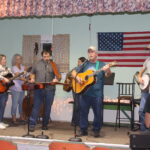Forest Service: Unauthorized trails a concern
Unauthorized trails are an increasing concern throughout the Mark Twain National Forest.
While the Forest maintains nearly 900 miles of trails that are open to the public for a variety of activities, including hiking, horseback riding, mountain biking and motorized use, the creation and maintenance of unauthorized trails outside of this system is on the rise.
Constructing, placing, and maintaining unauthorized trails on National Forest System lands violates federal regulations.
The use of unauthorized trails causes extensive damage to delicate natural resources, including the destruction of wildlife habitats, soil erosion, and sediment pollution of watersheds, a forest Service press release said. Additionally, sensitive cultural resources may be impacted, some of which are listed on the National Register of Historical Places and subject to protection under federal law.
When the Forest Service discovers unauthorized trails, especially ones that are regularly maintained, agency staff is required to close and block them to prevent continued use and further ecological and cultural resource damage.
The sustainability of the extensive trail network throughout the Mark Twain National Forest is not managed by agency staff alone. Trail stewardship groups such as the Ozark Trail Association and Back Country Horsemen partner with the Forest Service to ensure visitors can access ecologically- and geographically-sound trails.
“Unauthorized trail use causes natural resource damage, degrades watersheds and creates potentially hazardous situations for users,” said Kathie Brennan, Ozark Trail Association President. “And, partner organizations like the Ozark Trail Association take on most of the rehabilitation and repair work to restore these locations to their natural conditions.”
Back Country Horsemen similarly supports the strategically planned, sustainably managed, designated trail system within Mark Twain National Forest.
“Unauthorized trails can be damaging to the historical and culturally significant landscape resources and provide safety issues for all user groups,” said Sherry Copeland, past chairman of Back Country Horsemen of America.
She relays that the organization’s collaborative goal is to facilitate the service, education, and advocacy opportunities in support of the designated trail system as a guarantee for the use and enjoyment of future generations by ‘Keeping Trails Open for All!’” Protecting the natural and cultural resources on the public land the Forest Service manages is a tremendous priority and undertaking.
“Managing these trails is not something our staff can do on our own,” said Dawn Laybolt, forest supervisor. “We need help from visitors following the rules, our many volunteers who assist with hands-on projects, and our wonderful stewardship partners who can tackle larger maintenance needs.”
To avoid further damaging the resources around unauthorized trails, visitors are encouraged to view the various map resources available online at https://www.fs.usda.gov/main/mtnf/maps-pubs#rec and only access those trails that are officially designated and marked as such by the Forest Service.





